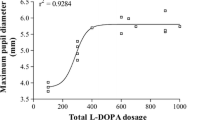Abstract
Purpose
To compare pupillary autonomic dysfunction in multiple system atrophy (MSA) and Parkinson’s disease (PD).
Methods
We administered eye-drop tests to 40 MSA patients, 40 PD patients with similar disease duration, and 20 age-matched healthy controls. Pupillary supersensitivity to a parasympathomimetic agent (0.05% pilocarpine hydrochloride) and to a sympathomimetic agent (0.02% dipivefrine hydrochloride) was examined by assessing changes in pupil diameter.
Results
Pupillary supersensitivity to a parasympathomimetic agent (0.05% pilocarpine hydrochloride) and to a sympathomimetic agent (0.02% dipivefrine hydrochloride) was examined by assessing changes in pupil diameter. Pupillary supersensitivity to 0.05% pilocarpine was greatest among the PD patients (PD −23.1 ± 14.4%, MSA −12.4 ± 11.5%, control −9.5 ± 8.2%, p < 0.05) but was not correlated with disease duration. Pupillary sensitivity to 0.02% dipivefrine was significantly greater in the PD and MSA patients versus controls (PD 10.5 ± 12.0%, MSA 11.8 ± 11.0%, control 3.1 ± 5.8%, p < 0.05). MSA patients had pupillary sympathetic dysfunction from an early stage, whereas in PD patients it tended to gradually accelerate as the disease advanced. In MSA patients, pupillary sympathetic sensitivity to 0.02% dipivefrine was correlated with the severity of orthostatic hypotension during a head-up tilt test and with the elevation of systolic blood pressure during a noradrenaline infusion test. In PD patients, pupillary sympathetic sensitivity to 0.02% dipivefrine was correlated with a reduction of the heart-to-mediastinum (H/M) ratio using delayed-phase iodine-123 meta-iodobenzylguanidine (123I-MIBG) myocardial scintigraphy.
Conclusion
These data indicate that eye-drop tests can reveal differences in the progression of pupillary autonomic dysfunction in patients with MSA and PD.




Similar content being viewed by others
References
Wenning GK, Colosimo C, Geser F, Poewe W (2004) Multiple system atrophy. Lancet Neurol 3:93–103
Gilman S, Low PA, Quinn N et al (1999) Consensus statement on the diagnosis of multiple system atrophy. J Neurol Sci 163:94–98
Daniel SE (1999) The neuropathology and neurochemistry of multiple system atrophy. In: Mathias CJ, Bannister SR (eds) Autonomic failure. Oxford University Press, Oxford, pp 321–328
Wenning GK, Tison F, Ben Shomo Y et al (1997) Multiple system atrophy: a review of 203 pathologically proven cases. Mov Disord 12:133–147
Gray F, Vincent D, Hauw JJ (1988) Quantitative study of lateral horn cells in 15 cases of multiple system atrophy. Acta Neuropathol 75:513–518
Oppenheimer DR (1980) Lateral horn cells in progressive autonomic failure. J Neurol Sci 46:393–404
Riley DE, Chelimsky TC (2003) Autonomic nervous system testing may not distinguish multiple system atrophy from Parkinson’s disease. J Neurol Neurosurg Psychiatry 74:56–60
Hori N, Takamori M, Fumitada Y, Hirayama M et al (2008) Pupillary supersensitivity and visual disturbance in Parkinson’s disease. Clin Auton Res 18:20–27
Nirankari VS et al (1982) Ocular manifestations of Shy-Drager syndrome. Ann Ophthalmol 14:635–638
Daniel SE, Lees AJ (1993) The clinical features of Parkinson’s disease in 100 histologically proven cases. Adv Neurol 60:595–599
Ishikawa S (2001) Normal data on pupillary dynamics. Neuro-ophthalmol Jpn 18:154–156
Shirley A, Smith SA, Smith SE (1999) Pupil function: tests and disorders. In: Bannister R, Mathias CJ (eds) Autonomic failure. A textbook of clinical disorders of the autonomic nervous system, 4th edn. Oxford University Press, Oxford, pp 245–253
Mathias CJ, Bannister R (1999) Investigation of autonomic disorders. Autonomic failure. In: Mathias CJ, Bannister R (eds) Autonomic failure. A textbook of clinical disorders of the autonomic nervous system, 4th edn. Oxford University Press, Oxford, pp 171–175
Polinsky R, Kopin I, Ebert M, Weise V (1981) Pharmacologic distinction of different orthostatic hypotension syndromes. Neurology 31:1–7
Niimi Y, Ieda T, Hirayama M, Koike Y, Sobue G, Hasegawa Y, Takahashi A (1999) Clinical and physiologic characteristics of autonomic failure with Parkinson’s disease. Clin Auton Res 9:139–144
Hamada K, Hirayama M, Watanabe H, Kobayashi R, Ito H, Ieda T, Koike Y, Sobue G (2003) Onset age and severity of motor impairment are associated with reduction of myocardial 123I-MIBG uptake in Parkinson’s disease. J Neurol Neurosurg Psychiatry 74:423–426
Jacobson DM (1990) Pupillary responses to dilute pilocarpine in preganglionic 3rd nerve disorders. Neurology 40:804–808
Sugiyama T, Utsumi T (1990) Pupillary dynamics in Parkinson’s disease. Neuro-ophthalmology 10:1–7
Sawada H, Yamakawa K, Yamakado H, Hosokawa R, Ohba M, Miyamoto K, Kawamura T, Shimohama S (2005) Cocaine and phenylephrine eye drop test for Parkinson disease. JAMA 293:932–934
Spokes EGS, Bannister R, Oppenheimer DR (1979) Multiple system atrophy with autonomic failure. Clinical, histological and neurochemical observations in four cases. J Neurol Sci 43:59–82
Matthews MR (1999) Autonomic ganglia and preganglionic neurons in autonomic failure. In: Bannister R, Mathias CJ (eds) Autonomic failure. A textbook of clinical disorders of the autonomic nervous system, 4th edn. Oxford University Press, Oxford, pp 329–339
Khurana RK (1994) Cholinergic dysfunction in Shy-Drager syndrome: effect of the parasympathomimetic agent, bethanechol. Clin Auton Res 4:5–13
Shy GM, Drager GA (1960) A neurological syndrome associated with orthostatic hypotension: a clinicopathological study. Arch Neural 2:511–527
Orimo S et al (2007) Degeneration of cardiac sympathetic nerve can occur in multiple system atrophy. Acta Neuropathol 113:81–86
Wenning GK, Ben Shomo Y, Hughes A, Daniel SE, Lees A, Quinn NP (2000) What clinical features are most useful to distinguish definite multiple system atrophy from Parkinson’s disease. J Neurol Neurosurg Psychiatry 68:434–440
Osaki Y, Wenning GK, Daniel SE et al (2002) Do published criteria improve clinical diagnostic accuracy in multiple system atrophy? Neurology 59:1486–1491
Author information
Authors and Affiliations
Corresponding author
Rights and permissions
About this article
Cite this article
Yamashita, F., Hirayama, M., Nakamura, T. et al. Pupillary autonomic dysfunction in multiple system atrophy and Parkinson’s disease: an assessment by eye-drop tests. Clin Auton Res 20, 191–197 (2010). https://doi.org/10.1007/s10286-009-0051-0
Received:
Accepted:
Published:
Issue Date:
DOI: https://doi.org/10.1007/s10286-009-0051-0




